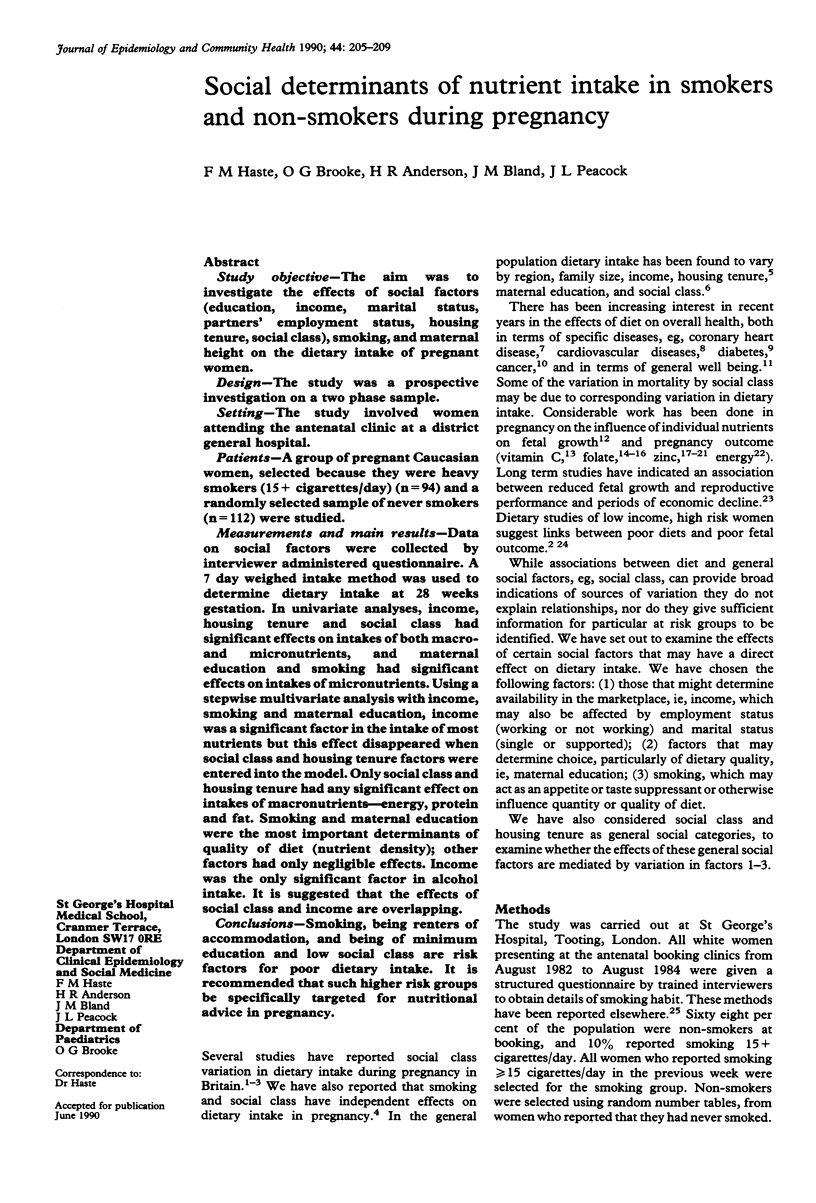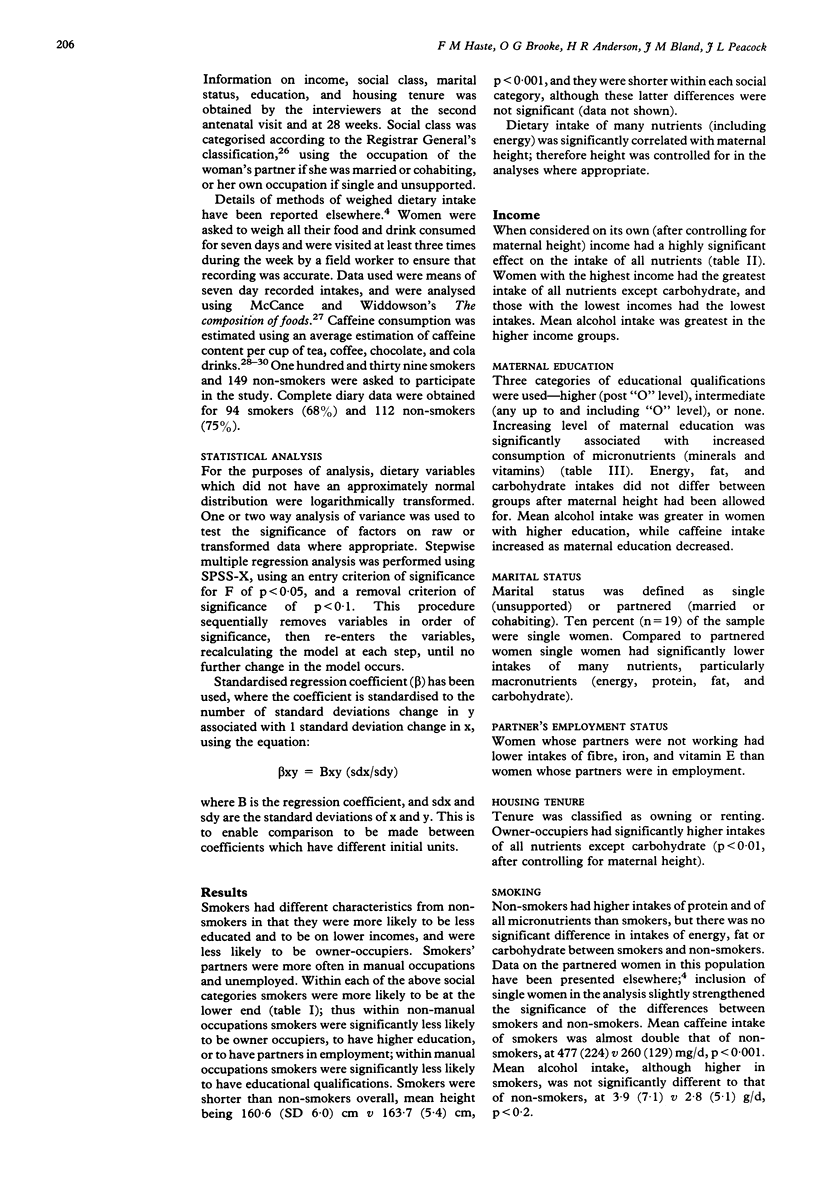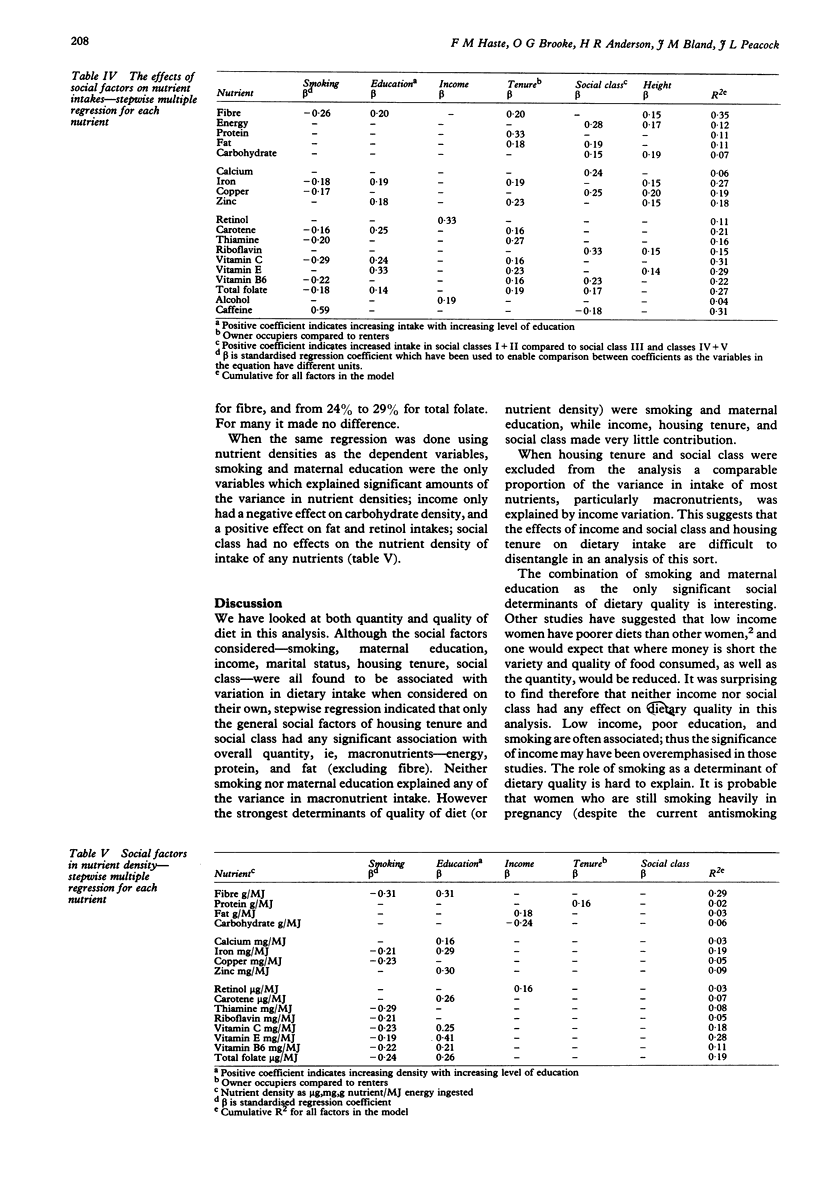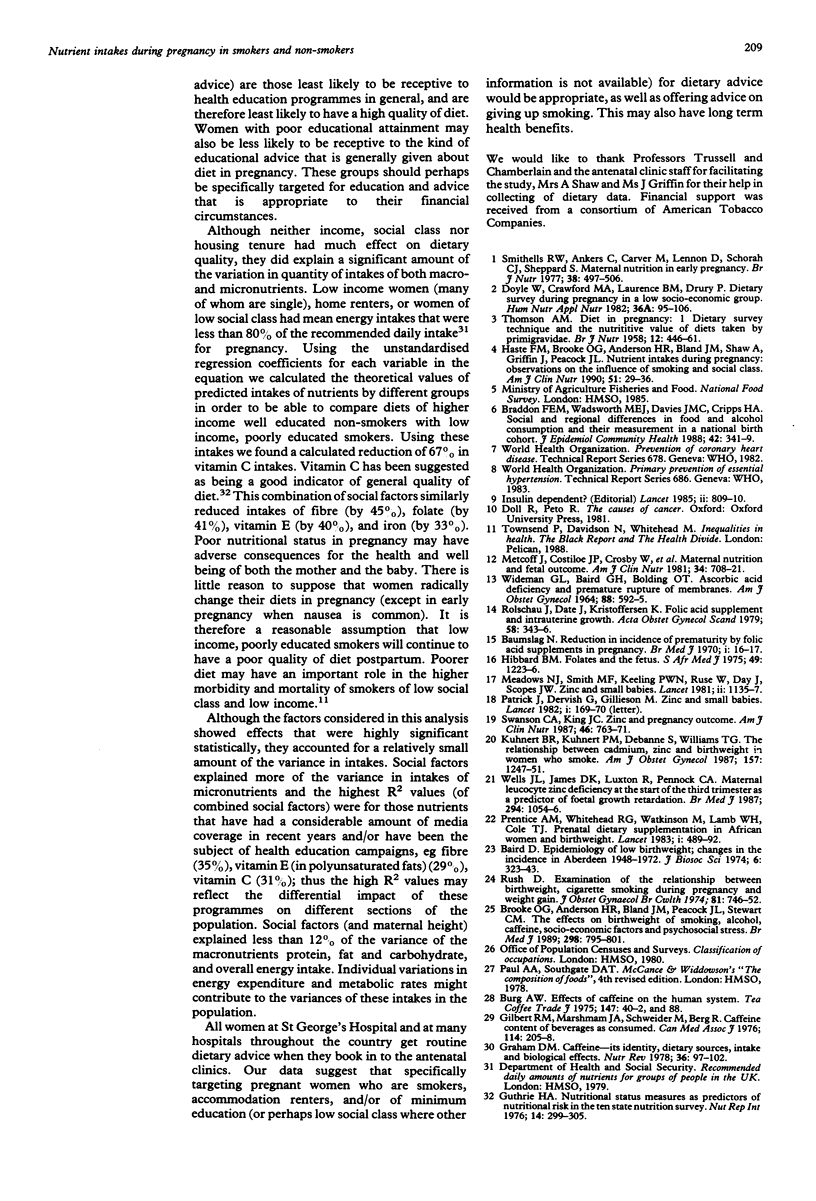Abstract
STUDY OBJECTIVE--The aim was to investigate the effects of social factors (education, income, marital status, partners' employment status, housing tenure, social class), smoking, and maternal height on the dietary intake of pregnant women. DESIGN--The study was a prospective investigation on a two phase sample. SETTING--The study involved women attending the antenatal clinic at a district general hospital. PATIENTS--A group of pregnant Caucasian women, selected because they were heavy smokers (15+ cigarettes/day) (n = 94) and a randomly selected sample of never smokers (n = 112) were studied. MEASUREMENTS AND MAIN RESULTS--Data on social factors were collected by interviewer administered questionnaire. A 7 day weighed intake method was used to determine dietary intake at 28 weeks gestation. In univariate analyses, income, housing tenure and social class had significant effects on intakes of both macro- and micronutrients, and maternal education and smoking had significant effects on intakes of micronutrients. Using a stepwise multivariate analysis with income, smoking and maternal education, income was a significant factor in the intake of most nutrients but this effect disappeared when social class and housing tenure factors were entered into the model. Only social class and housing tenure had any significant effect on intakes of macronutrients--energy, protein and fat. Smoking and maternal education were the most important determinants of quality of diet (nutrient density); other factors had only negligible effects. Income was the only significant factor in alcohol intake. It is suggested that the effects of social class and income are overlapping. CONCLUSIONS--Smoking, being renters of accommodation, and being of minimum education and low social class are risk factors for poor dietary intake. It is recommended that such higher risk groups be specifically targeted for nutritional advice in pregnancy.
Full text
PDF




Selected References
These references are in PubMed. This may not be the complete list of references from this article.
- Baird D. The epidemiology of low birth weight; changes in incidence in Aberdeen, 1948-72. J Biosoc Sci. 1974 Jul;6(3):323–341. doi: 10.1017/s0021932000009688. [DOI] [PubMed] [Google Scholar]
- Baumslag N., Edelstein T., Metz J. Reduction of incidence of prematurity by folic acid supplementation in pregnancy. Br Med J. 1970 Jan 3;1(5687):16–17. doi: 10.1136/bmj.1.5687.16. [DOI] [PMC free article] [PubMed] [Google Scholar]
- Braddon F. E., Wadsworth M. E., Davies J. M., Cripps H. A. Social and regional differences in food and alcohol consumption and their measurement in a national birth cohort. J Epidemiol Community Health. 1988 Dec;42(4):341–349. doi: 10.1136/jech.42.4.341. [DOI] [PMC free article] [PubMed] [Google Scholar]
- Brooke O. G., Anderson H. R., Bland J. M., Peacock J. L., Stewart C. M. Effects on birth weight of smoking, alcohol, caffeine, socioeconomic factors, and psychosocial stress. BMJ. 1989 Mar 25;298(6676):795–801. doi: 10.1136/bmj.298.6676.795. [DOI] [PMC free article] [PubMed] [Google Scholar]
- Doyle W., Crawford M. A., Laurance B. M., Drury P. Dietary survey during pregnancy in a low socio-economic group. Hum Nutr Appl Nutr. 1982 Apr;36(2):95–106. [PubMed] [Google Scholar]
- Gilbert R. M., Marshman J. A., Schwieder M., Berg R. Caffeine content of beverages as consumed. Can Med Assoc J. 1976 Feb 7;114(3):205–208. [PMC free article] [PubMed] [Google Scholar]
- Graham D. M. Caffeine--its identity, dietary sources, intake and biological effects. Nutr Rev. 1978 Apr;36(4):97–102. doi: 10.1111/j.1753-4887.1978.tb03717.x. [DOI] [PubMed] [Google Scholar]
- Haste F. M., Brooke O. G., Anderson H. R., Bland J. M., Shaw A., Griffin J., Peacock J. L. Nutrient intakes during pregnancy: observations on the influence of smoking and social class. Am J Clin Nutr. 1990 Jan;51(1):29–36. doi: 10.1093/ajcn/51.1.29. [DOI] [PubMed] [Google Scholar]
- Hibbard B. M. Folates and the fetus. S Afr Med J. 1975 Jul 16;49(30):1223–1226. [PubMed] [Google Scholar]
- Kuhnert B. R., Kuhnert P. M., Debanne S., Williams T. G. The relationship between cadmium, zinc, and birth weight in pregnant women who smoke. Am J Obstet Gynecol. 1987 Nov;157(5):1247–1251. doi: 10.1016/s0002-9378(87)80303-4. [DOI] [PubMed] [Google Scholar]
- Meadows N. J., Ruse W., Smith M. F., Day J., Keeling P. W., Scopes J. W., Thompson R. P., Bloxam D. L. Zinc and small babies. Lancet. 1981 Nov 21;2(8256):1135–1137. doi: 10.1016/s0140-6736(81)90587-0. [DOI] [PubMed] [Google Scholar]
- Metcoff J., Costiloe J. P., Crosby W., Bentle L., Seshachalam D., Sandstead H. H., Bodwell C. E., Weaver F., McClain P. Maternal nutrition and fetal outcome. Am J Clin Nutr. 1981 Apr;34(Suppl 4):708–721. doi: 10.1093/ajcn/34.4.708. [DOI] [PubMed] [Google Scholar]
- Patrick J., Dervish G., Gillieson M. Zinc and small babies. Lancet. 1982 Jan 16;1(8264):169–170. doi: 10.1016/s0140-6736(82)90419-6. [DOI] [PubMed] [Google Scholar]
- Prentice A. M., Whitehead R. G., Watkinson M., Lamb W. H., Cole T. J. Prenatal dietary supplementation of African women and birth-weight. Lancet. 1983 Mar 5;1(8323):489–492. doi: 10.1016/s0140-6736(83)92188-8. [DOI] [PubMed] [Google Scholar]
- Rolschau J., Date J., Kristoffersen K. Folic acid supplement and intrauterine growth. Acta Obstet Gynecol Scand. 1979;58(4):343–346. doi: 10.3109/00016347909154593. [DOI] [PubMed] [Google Scholar]
- Rush D. Examination of the relationship between birthweight, cigarette smoking during pregnancy and maternal weight gain. J Obstet Gynaecol Br Commonw. 1974 Oct;81(10):746–752. doi: 10.1111/j.1471-0528.1974.tb00374.x. [DOI] [PubMed] [Google Scholar]
- Smithells R. W., Ankers C., Carver M. E., Lennon D., Schorah C. J., Sheppard S. Maternal nutrition in early pregnancy. Br J Nutr. 1977 Nov;38(3):497–506. doi: 10.1079/bjn19770115. [DOI] [PubMed] [Google Scholar]
- Swanson C. A., King J. C. Zinc and pregnancy outcome. Am J Clin Nutr. 1987 Nov;46(5):763–771. doi: 10.1093/ajcn/46.5.763. [DOI] [PubMed] [Google Scholar]
- THOMSON A. M. Diet in pregnancy. I. Dietary survey technique and the nutritive value of diets taken by primigravidae. Br J Nutr. 1958;12(4):446–461. doi: 10.1079/bjn19580059. [DOI] [PubMed] [Google Scholar]
- WIDEMAN G. L., BAIRD G. H., BOLDING O. T. ASCORBIC ACID DEFICIENCY AND PREMATURE RUPTURE OF FETAL MEMBRANES. Am J Obstet Gynecol. 1964 Mar 1;88:592–595. doi: 10.1016/0002-9378(64)90885-3. [DOI] [PubMed] [Google Scholar]
- Wells J. L., James D. K., Luxton R., Pennock C. A. Maternal leucocyte zinc deficiency at start of third trimester as a predictor of fetal growth retardation. Br Med J (Clin Res Ed) 1987 Apr 25;294(6579):1054–1056. doi: 10.1136/bmj.294.6579.1054. [DOI] [PMC free article] [PubMed] [Google Scholar]


